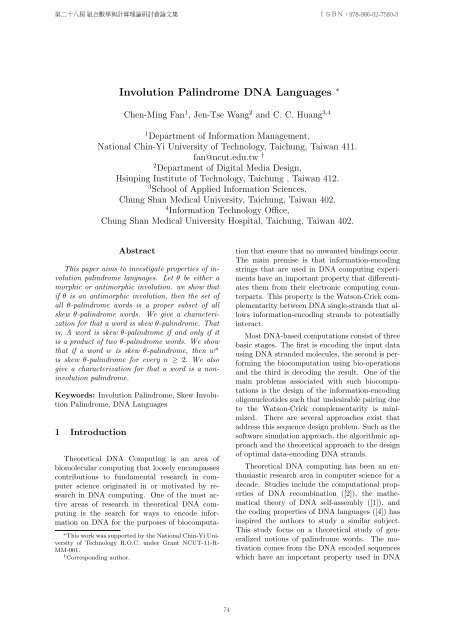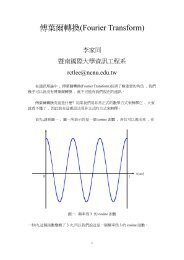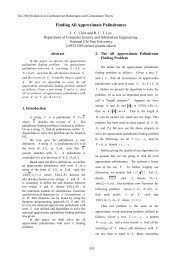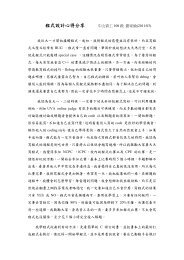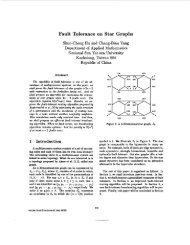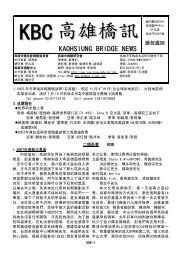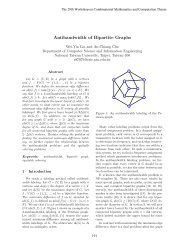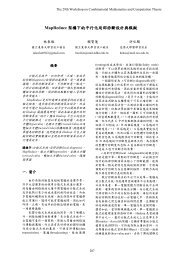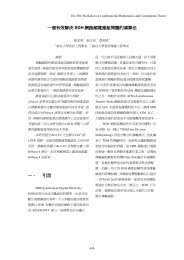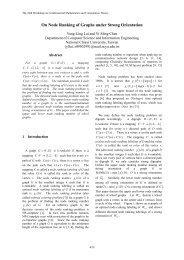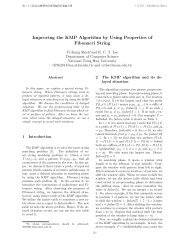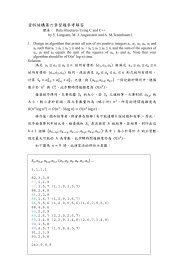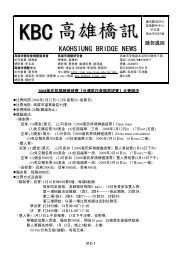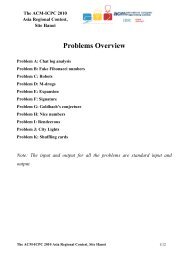Involution Palindrome DNA Languages
Involution Palindrome DNA Languages
Involution Palindrome DNA Languages
You also want an ePaper? Increase the reach of your titles
YUMPU automatically turns print PDFs into web optimized ePapers that Google loves.
<strong>Involution</strong> <strong>Palindrome</strong> <strong>DNA</strong> <strong>Languages</strong> ∗<br />
Chen-Ming Fan 1 , Jen-Tse Wang 2 and C. C. Huang 3,4<br />
1 Department of Information Management,<br />
National Chin-Yi University of Technology, Taichung, Taiwan 411.<br />
fan@ncut.edu.tw †<br />
2 Department of Digital Media Design,<br />
Hsiuping Institute of Technology, Taichung , Taiwan 412.<br />
3 School of Applied Information Sciences,<br />
Chung Shan Medical University, Taichung, Taiwan 402.<br />
4 Information Technology Office,<br />
Chung Shan Medical University Hospital, Taichung, Taiwan 402.<br />
Abstract<br />
This paper aims to investigate properties of involution<br />
palindrome languages. Let θ be either a<br />
morphic or antimorphic involution. we show that<br />
if θ is an antimorphic involution, then the set of<br />
all θ-palindrome words is a proper subset of all<br />
skew θ-palindrome words. We give a characterization<br />
for that a word is skew θ-palindrome. That<br />
is, A word is skew θ-palindrome if and only if it<br />
is a product of two θ-palindrome words. We show<br />
that if a word w is skew θ-palindrome, then w n<br />
is skew θ-palindrome for every n ≥ 2. We also<br />
give a characterization for that a word is a noninvolution<br />
palindrome.<br />
Keywords: <strong>Involution</strong> <strong>Palindrome</strong>, Skew <strong>Involution</strong><br />
<strong>Palindrome</strong>, <strong>DNA</strong> <strong>Languages</strong><br />
1 Introduction<br />
Theoretical <strong>DNA</strong> Computing is an area of<br />
biomolecular computing that loosely encompasses<br />
contributions to fundamental research in computer<br />
science originated in or motivated by research<br />
in <strong>DNA</strong> computing. One of the most active<br />
areas of research in theoretical <strong>DNA</strong> computing<br />
is the search for ways to encode information<br />
on <strong>DNA</strong> for the purposes of biocomputa-<br />
∗ This work was supported by the National Chin-Yi University<br />
of Technology R.O.C. under Grant NCUT-11-R-<br />
MM-001.<br />
† Corresponding author.<br />
tion that ensure that no unwanted bindings occur.<br />
The main premise is that information-encoding<br />
strings that are used in <strong>DNA</strong> computing experiments<br />
have an important property that differentiates<br />
them from their electronic computing counterparts.<br />
This property is the Watson-Crick complementarity<br />
between <strong>DNA</strong> single-strands that allows<br />
information-encoding strands to potentially<br />
interact.<br />
Most <strong>DNA</strong>-based computations consist of three<br />
basic stages. The first is encoding the input data<br />
using <strong>DNA</strong> stranded molecules, the second is performing<br />
the biocomputation using bio-operations<br />
and the third is decoding the result. One of the<br />
main problems associated with such biocomputations<br />
is the design of the information-encoding<br />
oligonucleotides such that undesirable pairing due<br />
to the Watson-Crick complementarity is minimized.<br />
There are several approaches exist that<br />
address this sequence design problem. Such as the<br />
software simulation approach, the algorithmic approach<br />
and the theoretical approach to the design<br />
of optimal data-encoding <strong>DNA</strong> strands.<br />
Theoretical <strong>DNA</strong> computing has been an enthusiastic<br />
research area in computer science for a<br />
decade. Studies include the computational properties<br />
of <strong>DNA</strong> recombination ([2]), the mathematical<br />
theory of <strong>DNA</strong> self-assembly ([1]), and<br />
the coding properties of <strong>DNA</strong> languages ([4]) has<br />
inspired the authors to study a similar subject.<br />
This study focus on a theoretical study of generalized<br />
notions of palindrome words. The motivation<br />
comes from the <strong>DNA</strong> encoded sequences<br />
which have an important property used in <strong>DNA</strong>
computing. This property is the Watson-Crick<br />
complementarity between <strong>DNA</strong> single-strands. A<br />
single strand of <strong>DNA</strong> can be abstracted as a string<br />
sequence consisted of a combination of four different<br />
symbols. The four symbols are adenine (A),<br />
guanine (G), cytosine (C) and thymine (T ). The<br />
Watson-Crick complement of a <strong>DNA</strong> strand satisfies<br />
two main properties, it is the reverse property<br />
and the complement property of the original<br />
strand. Mathematically, the Watson-Crick complementarity<br />
is translated into generalizing the<br />
identity involution. An involution is a function θ<br />
such that θ 2 equals the identity, that is, θ(A) = T<br />
and θ 2 (A) = θ(θ(A)) = A. Furthermore, for the<br />
<strong>DNA</strong> alphabet ∆ = {A, G, C, T }, an antimorphic<br />
involution is an involution θ with the additional<br />
property that θ(uv) = θ(v)θ(u) for all string sequences<br />
u, v ∈ ∆ ∗ , corresponds to the notion of<br />
the Watson-Crick complement of a <strong>DNA</strong> sequence.<br />
2 Preliminaries<br />
Assume X is an alphabet containing more than<br />
one letter. Let X ∗ be the free monoid generated by<br />
X. Every element of X ∗ is a word and every subset<br />
of X ∗ is a language. Let λ denote the empty word,<br />
and X + = X ∗ \{λ}. For w ∈ X ∗ and L ⊆ X ∗ ,<br />
let lg(w) denote the length of the word w and let<br />
|L| denote the cardinality of the language L. A<br />
language L ⊆ X ∗ is dense if for any w ∈ X ∗ , there<br />
exist x, y ∈ X ∗ such that xwy ∈ L. That is, for<br />
every w ∈ X ∗ , X ∗ wX ∗ ∩ L ≠ ∅. A primitive word<br />
is a word which is not a power of any other word.<br />
Let Q be the set of all primitive words over X.<br />
Every word u ∈ X + can be expressed as a power<br />
of a primitive word in a unique way, that is, for any<br />
u ∈ X + , u = f n for a unique f ∈ Q and n ≥ 1. In<br />
this case, f is the primitive root of u and denoted<br />
by √ u = f. Let u = a 1 a 2 · · · a n where a i ∈ X.<br />
The reverse of the word u is u R = a n · · · a 2 a 1 . A<br />
word u is called palindrome if u = u R . Let R<br />
be the set of all palindrome words over X. The<br />
partial order relation ≤ p (resp. ≤ s ) is defined as:<br />
for u, v ∈ X ∗ , v ≤ p u (resp. v ≤ s u) if and only if<br />
u ∈ vX ∗ (resp. u ∈ X ∗ v). Moreover, the partial<br />
order relation < p (resp. < s ) is defined as: for<br />
u, v ∈ X + , v < p u (resp. v < s u) if and only if<br />
u ∈ vX + (resp. u ∈ X + v).<br />
Let θ : X ∗ → X ∗ be a function such that θ 2 = I<br />
where I is the identity function. It can extend to<br />
a morphic involution on X ∗ if for all u, v ∈ X ∗ ,<br />
θ(uv) = θ(u)θ(v) or an antimorphic involution if<br />
θ(uv) = θ(v)θ(u). We now recall some definitions<br />
introduced by Kari and Mahalingam ([5]-[7]).<br />
Definition 2.1 Let θ be either a morphic or an<br />
antimorphic involution on X ∗ .<br />
(1) A word w is a θ-conjugate of another word u<br />
if uv = θ(v)w for some v ∈ X ∗ .<br />
(2) A word w ∈ X ∗ is called a θ-palindrome word<br />
if w = θ(w).<br />
We also recall some observations on the above<br />
definitions. Let σ(u) be the set containing all θ-<br />
conjugates of u. For example, let X = {a, b}<br />
and θ be a morphic involution that maps a to<br />
b and vice versa. For u = ababb, σ(u) =<br />
{babaa, bbaba, bbbab, abbba, babbb, ababb}. Moreover,<br />
let θ be an antimorphic involution that maps<br />
a to b and vice versa. For u = ababb, σ(u) =<br />
{aabab, babab, bbbab, abbab, babbb, ababb}. Let R θ<br />
be the set of all θ-palindrome words over X. Note<br />
that aabb ∈ R θ where θ is antimorphic involution,<br />
but aabb ∉ R. For any antimorphic involution θ,<br />
we give a definition of skew θ-palindrome words as<br />
following:<br />
Definition 2.2 Let θ be an antimorphic involution<br />
on X ∗ . A word w is said to be skew θ-<br />
palindrome if w = xy implies that θ(w) = yx for<br />
some x, y ∈ X ∗ .<br />
Let θ is an antimorphic involution on X ∗ .<br />
Note that every θ-palindrome word is a skew θ-<br />
palindrome word because any palindrome word as<br />
a product of itself and the empty word λ. For example,<br />
abab is θ-palindrome and is also a skew θ-<br />
palindrome word. Let w = abba. Then w is a skew<br />
θ-palindrome word, but it is not θ-palindrome.<br />
Furthermore, we give some results which will<br />
be used in the rest of this study as follows:<br />
Lemma 2.1(see [13]) Let u, v ∈ X + . Then uv =<br />
vu implies that u and v are powers of a common<br />
word.<br />
Lemma 2.2(see [13]) If u m = v n and m, n ≥ 1,<br />
then u and v are powers of a common word.<br />
3 <strong>Involution</strong> <strong>Palindrome</strong> <strong>Languages</strong><br />
A word u is called palindrome if it is the mirror<br />
image of itself. In this section we extend the<br />
concept of palindrome words to incorporate the
notion of involution function. The notion of θ-<br />
palindrome was defined in [6] and obtained independently<br />
in [8]. Note that if θ is the Watson-Crick<br />
involution, then the notion of Watson-Crick palindromes<br />
coincides with the term ”palindrome” as<br />
used in molecular biology, especially in the study<br />
of enzymes.<br />
The study of θ-palindromes for antimorphic involutions<br />
is interesting from two points of view:<br />
firstly, it may be desirable for certain <strong>DNA</strong> computing<br />
experiments to use <strong>DNA</strong> strands that contain<br />
θ-palindromic enzyme restriction sites as subwords,<br />
and secondly, in general, a set of <strong>DNA</strong><br />
codewords should be free of θ-palindromic words,<br />
due to the intermolecular hybridizations that these<br />
would entail.<br />
This study extends the understanding of involution<br />
palindrome words (θ-palindrome words).<br />
This notion is motivated by <strong>DNA</strong> strand design<br />
in the area of biocomputing where the Watson-<br />
Crick complementarity can be abstracted as an<br />
antimorphic involution function. A language consisting<br />
of involution palindrome words is defined as<br />
an involution palindrome language. Some properties<br />
of involution palindrome words and languages<br />
are surveyed in our study. Besides involution<br />
palindrome words being considered, some<br />
algebraic properties of skew involution palindrome<br />
words are studied as well.<br />
Lemma 3.1 ([3]) Let θ be a morphic or an antimorphic<br />
involution. The word f ∈ X + is primitive<br />
if and only if θ(f) is primitive word.<br />
Let w ∉ Q. That is, w = f k , f ∈ Q, k ≥ 2. Then<br />
the primitive root of w is denoted by √ w = f.<br />
Lemma 3.2 ([3]) Let θ be a morphic or an antimorphic<br />
involution. Let w ∈ X + . Then θ( √ w) =<br />
√<br />
θ(w).<br />
For a language L, L (i) = {w i | w ∈ L} for any<br />
i ≥ 1. Then we have Q (i) = {u i | u ∈ Q}.<br />
Lemma 3.3 ([7]) Let θ be a morphic or an antimorphic<br />
involution. For all w ∈ X + , w is θ-<br />
palindrome if and only if √ w is θ-palindrome.<br />
Lemma 3.4 ([7]) Let θ be an antimorphic involution.<br />
Then for w ∈ X + , w ∈ R θ if and only if<br />
w = xyθ(x), x ∈ X + , y ∈ X ∗ with y ∈ R θ .<br />
Proposition 3.1 ([3]) Let θ be an antimorphic<br />
involution. Then √ R θ = R θ ∩ Q.<br />
In the following propositions, we investigate the<br />
properties concerning R θ 2 . When θ is an antimorphic<br />
involution, we show that (R θ 2 ∩ Q) ∩ R θ =<br />
∅. Moreover, when θ is a morphic involution,<br />
(R θ 2 ∩ Q) ⊆ R θ .<br />
Proposition 3.2 ([3]) Let w = uv ∈ Q with u, v ∈<br />
R θ where u, v ∈ X + .<br />
(1) If θ is an antimorphic involution, then w ∉ R θ .<br />
(2) If θ is a morphic involution, then w ∈ R θ .<br />
Proposition 3.3 ([3]) Let θ be an antimorphic<br />
involution and w = uv ∈ R θ ∩ Q where u, v ∈ X + .<br />
If u ∈ R θ , then vu ∉ R θ .<br />
A word u ∈ X ∗ is a conjugate of w ∈ X ∗ if<br />
there exists v ∈ X ∗ such that uv = vw. In [6],<br />
authors have defined the θ-conjugate of a word for<br />
a morphic involution θ or an antimorphic involution<br />
θ as follow: w ∈ X ∗ is a θ-conjugate of u<br />
such that uv = θ(v)w for some v ∈ X ∗ . We study<br />
the θ-conjugate of a word concerning θ-palindrome<br />
words in the following propositions.<br />
Lemma 3.5 ([6]) Let w be a θ-conjugate of u.<br />
Then for a morphic involution θ, there exist x, y ∈<br />
X ∗ such that u = xy and one of the following hold:<br />
(1) w = yθ(x) and v = ( θ(x)θ(y)xy ) i<br />
θ(x) for some<br />
i ≥ 0.<br />
(2) w = θ(y)x and v = ( θ(x)θ(y)xy ) i<br />
θ(x)θ(y)x for<br />
some i ≥ 0.<br />
Proposition 3.4 ([3]) Let u ∈ X + be a θ-<br />
palindrome word. Then for a morphic involution<br />
θ, any θ-conjugate of u is also θ-palindrome and is<br />
the product of two θ-palindrome words.<br />
Lemma 3.6 ([6]) Let w be a θ-conjugate of u.<br />
Then for an antimorphic involution θ, there exist<br />
x, y ∈ X ∗ such that either u = xy and w = yθ(x)<br />
or w = θ(u).<br />
Proposition 3.5 ([3]) Let u ∈ X + be a θ-<br />
palindrome word. Then for an antimorphic involution<br />
θ, any θ-conjugate w ∈ X + of u is one of<br />
the following:<br />
(1) w is also θ-palindrome.<br />
(2) w ∈ {αβ 2 , βαβ} with α ∈ R θ for some α ∈<br />
X ∗ , β ∈ X + .
In the following propositions, some properties<br />
of the skew θ-palindrome words are studied when<br />
θ is an antimorphic involution.<br />
Proposition 3.6 Let θ be an antimorphic involution<br />
on X ∗ . A word w is skew θ-palindrome if and<br />
only if w is a product of two θ-palindrome words.<br />
Proof. Let θ be an antimorphic involution on<br />
X ∗ . If w is skew θ-palindrome, then there exist<br />
u, v ∈ X ∗ such that w = uv, θ(w) = vu. Since<br />
θ is an antimorphic involution, θ(w) = θ(uv) =<br />
θ(v)θ(u). We have θ(v)θ(u) = vu. Hence θ(v) = v<br />
and θ(u) = u. Then w is a product of two θ-<br />
palindrome words. Conversely, suppose that w =<br />
uv where u = θ(u), v = θ(v) for some u, v ∈ X ∗ .<br />
Then θ(w) = θ(uv) = θ(v)θ(u) = vu; hence w is a<br />
skew θ-palindrome word.<br />
Proposition 3.6 is not true where θ is a morphic<br />
involution. For example, let X = {a, b} and θ be<br />
a morphic involution that maps a to b and vice<br />
versa. As w = ab, θ(w) = θ(ab) = θ(a)θ(b) = ba.<br />
Then w is skew θ-palindrome. However, a, b are<br />
not θ-palindromes. Note that every θ-palindrome<br />
word is a skew θ-palindrome word because any<br />
palindrome word as a product of itself and the<br />
empty word λ.<br />
Lemma 3.7([7]) Let θ be an antimorphic involution.<br />
Then for u, v ∈ X + , u, v ∈ R θ if and only if<br />
(uv) k u ∈ R θ for some k ≥ 0.<br />
Proposition 3.7 Let θ be an antimorphic involution.<br />
If w is skew θ-palindrome, then for n ≥ 2,<br />
w n has at least two different decompositions as<br />
product of two θ-palindromes.<br />
Proof. Let θ be an antimorphic involution and<br />
w be a skew θ-palindrome word. By Proposition<br />
3.6, there exist w 1 , w 2 ∈ R θ such that w = w 1 w 2 .<br />
Then<br />
w n = w 1<br />
(<br />
(w2 w 1 ) n−1 w 2<br />
)<br />
= (w 1 w 2 w 1 ) ( (w 2 w 1 ) n−2 w 2<br />
)<br />
.<br />
Moreover, by Lemma 3.7, we have that<br />
(w 1 w 2 ) i w 1 and (w 2 w 1 ) j w 2 for i, j ≥ 0 are θ-<br />
palindromes. This complete the proof.<br />
Proposition 3.8 Let θ be an antimorphic involution.<br />
A word w is skew θ-palindrome if and only<br />
if w n is skew θ-palindrome for n ≥ 2.<br />
Proof. Let θ be an antimorphic involution. If w<br />
is skew θ-palindrome, by Propositions 3.6 and 3.7,<br />
then w n is skew θ-palindrome for n ≥ 2. Conversely,<br />
let w n be a skew θ-palindrome word for<br />
n ≥ 2. There exist w 1 , w 2 ∈ X + with w = w 1 w 2<br />
such that w n = (w i w 1 )(w 2 w j ) where i + j = n − 1<br />
for some i, j ≥ 0. By the definition of skew θ-<br />
palindrome word, we have θ(w n ) = (w 2 w j )(w i w 1 ).<br />
Since θ is an antimorphic involution,<br />
θ(w n ) = θ ( (w i w 1 )(w 2 w j ) )<br />
= θ(w 2 w j )θ(w i w 1 )<br />
= ( θ(w) ) j<br />
θ(w2 )θ(w 1 ) ( θ(w) ) i<br />
= ( θ(w 2 )θ(w 1 ) ) j<br />
θ(w2 ) ( θ(w 1 )θ(w 2 ) ) i<br />
θ(w1 )<br />
= (w 2 w j )(w i w 1 ).<br />
This implies that θ(w 1 ) = w 1 and θ(w 2 ) = w 2 .<br />
By Proposition 3.6, w is skew θ-palindrome.<br />
Given an involution θ, for any skew θ-<br />
palindrome word u, there exists a unique pair<br />
(x, y) such that u = pq and p = (xy) i−k−1 x, q =<br />
y(xy) k . We call (x, y) the twin-roots of u with respect<br />
to θ, or shortly θ-twin-roots of u.([12])<br />
4 The Non-<strong>Involution</strong> <strong>Palindrome</strong><br />
Words<br />
In this section, we study the words which are<br />
not θ-palindrome for an antimorphic involution θ.<br />
To characterize the properties of non-involution<br />
palindrome words, we consider the θ-commutative<br />
relation which was defined in [6]. Let θ be either a<br />
morphic or an antimorphic involution. We recall<br />
that the θ-commutative relation in [6] is as follow:<br />
the θ-commutative relation ≤ θ c on X ∗ is defined<br />
by<br />
v ≤ θ c u ⇔ u = vx = θ(x)v for some x ∈ X ∗ ,<br />
where u, v ∈ X ∗ .<br />
For u ∈ X ∗ , let L θ c(u) = {v ∈ X ∗ |v ≤ θ c u}<br />
and N(u) = |L θ c(u)|. For i ≥ 1, let C θ (i) = {u ∈<br />
X + |N(u) = i}. For example, let X = {a, b} and<br />
θ be an antimorphic involution that maps a to b<br />
and vice versa. Let u = ab. We have<br />
• u = ab · 1 = θ(1) · ab,<br />
• u = a · b ≠ θ(b) · a = aa,<br />
• u = 1 · ab = θ(ab) · 1 = θ(b)θ(a) = ab.<br />
Then 1, ab ∈ L θ c(ab); hence ab ∈ C θ (2). Note<br />
that the word ab is θ-palindrome for an antimorphic<br />
involution θ. However, the word ab ∈ C θ (1)
and is not θ-palindrome for a morphic involution<br />
θ.<br />
In [6], authors observe that a word in C θ (1) is<br />
not a θ-palindrome word when θ is an antimorphic<br />
involution. In the following lemma, we prove this<br />
observation in detail.<br />
Lemma 4.1 ([3]) Let θ be an antimorphic involution.<br />
Then a word u ∈ C θ (1) if and only if u ∉ R θ .<br />
For a word u ∈ X + , let Pref(u) = {x ∈ X + |<br />
x ≤ p u} and Suff(u) = {x ∈ X + | x ≤ s u}.<br />
Proposition 4.1 ([3]) Let θ be an antimorphic<br />
involution and u ∈ X + be such that θ(Pref(u)) ∩<br />
Suff(u) = ∅. Then u ∉ R θ .<br />
The converse of the statement in Proposition<br />
4.1 does not hold in general. Let X = {a, b} and<br />
θ be an antimorphic involution that maps a to<br />
b and vice verse. Let u = aab. Then θ(aab) =<br />
θ(b)θ(a)θ(a) = abb ≠ aab, that is, u ∉ R θ . But<br />
b ∈ θ(Pref(aab)) ∩ Suff(aab).<br />
Corollary 4.1 ([3]) Let θ be an antimorphic involution<br />
and u ∈ X + be such that θ(Pref(u)) ∩<br />
Suff(u) = ∅. Then u + ⊈ R θ .<br />
In the following proposition, we study the characteristic<br />
of non-involution palindrome word uv<br />
for any non-empty words u and v. First, we give<br />
a known result we need.<br />
Lemma 4.2 ([6]) Let θ be an antimorphic involution<br />
and let u, v ∈ C θ (1). If θ(Pref(u))∩Suff(v) =<br />
∅, then uv ∉ C θ (1).<br />
Proposition 4.2 ([3]) Let θ be an antimorphic<br />
involution. Let u, v ∈ X + with θ(Pref(u)) ∩<br />
Suff(v) = ∅. Then uv ∉ R θ .<br />
The converse of the statement in Proposition<br />
4.2 does not hold in general. Let X = {a, b} and θ<br />
be an antimorphic involution that maps a to b and<br />
vice verse. Let u = aba and v = ab. Then uv =<br />
abaab ≠ θ(uv) = abbab; hence uv ∉ R θ . However,<br />
from θ(Pref(u)) = {b, ab, aba} and Suff(v) =<br />
{b, ab}, we have b, ab ∈ θ(Pref(aba)) ∩ Suff(ab);<br />
hence θ(Pref(u)) ∩ Suff(v) ≠ ∅.<br />
Corollary 4.2 ([3]) Let θ be an antimorphic involution.<br />
Let u, v ∈ X + with θ(Pref(u)) ∩ Suff(v) =<br />
∅. Then uv k ∉ R θ for any k > 1.<br />
Corollary 4.3 ([3]) Let θ be an antimorphic involution<br />
and u, v ∈ X + . If θ(Pref(u)) ∩ Suff(v) = ∅,<br />
then u k v /∈ R θ for every k > 1.<br />
Proposition 4.3 ([3]) Let θ be an antimorphic involution<br />
and u, v ∈ X + . If θ(Pref(u)) ∩ Suff(v) =<br />
∅, then u + v + ⊈ R θ .<br />
In the following, we give a characterization for<br />
u ∉ R θ where u ∈ X + for X = {a, b}. We first<br />
need the following lemma.<br />
Lemma 4.3 Let X = {a, b} and θ be an antimorphic<br />
involution that maps a to b and vice<br />
verse. Let u ∈ X n , n ≥ 1. Let u = u 1 u 2 · · · u n ,<br />
where u i ∈ X for every 1 ≤ i ≤ n. Suppose<br />
that u ∈ R θ . Then n = 2k for some k ≥ 1 and<br />
θ(u k+1 · · · u 2k ) = u 1 · · · u k .<br />
Proof. Let X = {a, b} and θ be an antimorphic<br />
involution that maps a to b and vice verse. Let<br />
u ∈ X n , n ≥ 1. Let u = u 1 u 2 · · · u n , where u i ∈ X<br />
for every 1 ≤ i ≤ n. Suppose that u ∈ R θ . Then<br />
θ(u) = u. That is, θ(u n ) · · · θ(u 1 ) = u 1 · · · u n . If<br />
n = 1, then u = a or u = b. That is, θ(u) =<br />
θ(a) = b or θ(u) = θ(b) = a. Both contradict to<br />
u ∈ R θ . Hence n ≠ 1. If n = 2k +1 for some k ≥ 1,<br />
then θ(u 2k+1 ) · · · θ(u k+2 )θ(u k+1 )θ(u k ) · · · θ(u 1 ) =<br />
u 1 · · · u k u k+1 u k+2 · · · u 2k+1 . This implies that<br />
θ(u k+1 ) = u k+1 , a contradiction. Hence n ≠ 2k+1<br />
for every k ≥ 1. By above discussion, n is even.<br />
That is, n = 2k for some k ≥ 1. Now by the definition<br />
of θ-palindrome, we have θ(u k+1 · · · u 2k ) =<br />
u 1 · · · u k .<br />
Proposition 4.4 Let θ be an antimorphic involution<br />
that maps a to b and vice verse. Let u ∈ X n ,<br />
n ≥ 1. Let u = u 1 u 2 · · · u n , where u i ∈ X for every<br />
1 ≤ i ≤ n. Then u ∉ R θ if and only if one of the<br />
following conditions holds:<br />
(1) n is odd;<br />
(2) n is even and there exists an integer i <<br />
1<br />
2 lg(u) such that θ(u 1 · · · u i ) = u n−i+1 · · · u n and<br />
θ(u 1 · · · u i u i+1 ) = u n−i · · · u n .<br />
Proof. Let θ be an antimorphic involution. Let<br />
u ∈ X n , n ≥ 1. Let u = u 1 u 2 · · · u n , where u i ∈ X<br />
for every 1 ≤ i ≤ n.<br />
(⇐) If u ∈ R θ , then by Lemma 4.3, n = 2k<br />
for some k ≥ 1 and θ(u k+1 · · · u 2k ) = u 1 · · · u k .<br />
Since n = 2k for some k ≥ 2, (1) is not true.<br />
From θ(u k+1 · · · u 2k ) = u 1 · · · u k , we have that<br />
θ(u 2k ) · · · θ(u k+1 ) = u 1 · · · u k . This implies that<br />
(2) is not true.<br />
(⇒) Clearly.
Acknowledgement: The authors would like to<br />
thank the referees for their careful reading of the<br />
manuscript and useful suggestions.<br />
References<br />
[1] L. Adleman, Towards a Mathematical Theory<br />
of Self-assembly, Technical Report, 00722<br />
(2000), Department of Computer Science, University<br />
of Southern California.<br />
[2] M. Daley and I. McQuillan, On Computational<br />
Properties of Template-guided <strong>DNA</strong> Recomination,<br />
Proceeding of <strong>DNA</strong> Computing 11,<br />
LNCS 3892 (2006), 27–37.<br />
[11] L. Kari, K. Mahalingam, G. Thierrin, The<br />
syntactic monoid of hairpin-free languages.<br />
Acta Inform. 44(3)(2007), pp. 153-166.<br />
[12] L. Kari, K. Mahalingam, S. Seki, Twin-roots<br />
of words and their properties. Theor Comput<br />
Sci 410 (24-25)(2009), pp. 2393-2400.<br />
[13] S. S. Yu, Lecture Notes: <strong>Languages</strong> and<br />
Codes, Department of Computer Science, National<br />
Chung-Hsing University, Taichung, Taiwan<br />
402 (2003).<br />
[3] C. M. Fan, and C. C. Huang, Some Properties<br />
of <strong>Involution</strong> <strong>Palindrome</strong> <strong>Languages</strong>, International<br />
Journal of Computer Mathematics, Vol.<br />
87, No. 15, December 2010, 3397-3404.<br />
[4] S. Hussini, L. Kari and S. Konstantinidis, Coding<br />
Properties of <strong>DNA</strong> <strong>Languages</strong>, Theoretical<br />
Computer Science, 209 (2003), 1557–1579.<br />
[5] L. Kari and K. Mahalingam, Involutively bordered<br />
words, International Journal of Foundations<br />
of Computer Science, 18 (2007), No.5,<br />
1089–1106.<br />
[6] L. and K. Mahalingam, Watson-Crick Conjugate<br />
and Commutative Words, Preproceedings<br />
of the International Conference on <strong>DNA</strong><br />
13, Lecture Notes in Computer Science, 4848<br />
(2008), 273–283.<br />
[7] Lila Kari and Kalpana Mahalingam, Watson-<br />
Crick palindromes in <strong>DNA</strong> Computing, Natural<br />
Computing, DOI: 10.1007/s11047-009-<br />
9131-2 (2009).<br />
[8] A. de Luca and A. De Luca, Pseudopalindrome<br />
closure operators in free monoids, Theoretical<br />
Computer Science, 362(2006), Issue 1-3, 282-<br />
300.<br />
[9] M. Garzon, V. Phan, S. Roy, and A. Neel, In<br />
Search of Optimal Codes for <strong>DNA</strong> Computing,<br />
Proceedings of the <strong>DNA</strong> computing 12. C.<br />
Mao, T. Yokomori, Editors, LNCS 4287(2006),<br />
143-156.<br />
[10] N. Jonoska, K. Mahalingam, and J. Chen,<br />
<strong>Involution</strong> codes: with application to <strong>DNA</strong><br />
coded languages. Natural Computing 4(2)<br />
(2005), pp. 141-162.


